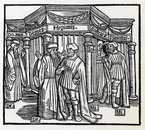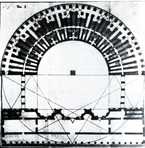Important events
(1556) An Italian translation with extended commentary of Vitruvius' Ten Books of Architecture, published as Dieci libri dell'architettura di M. Vitruvio. The work was dedicated to Cardinal Ippolito II d'Este, patron of the Villa d'Este at Tivoli.
(1567) He later published a Latin edition entitled M. Vitruvii de architectura. The original illustrations of Vitruvius' work have not survived, and Barbaro's illustrations were done specially by Andrea Palladio. As well as being important as a discussion of architecture, Barbaro's commentary was a contribution to the field of aesthetics in general. El Greco, for example, owned a copy. Earlier translations had been made, by Fra Giovanni and Como, but this work was considered the most accurate version to date. Barbaro clearly explained some of the more technical sections and discussed the relationship between nature and architecture, though he also acknowledged the way Palladio's theoretical and archeological expertise contributed to the work.
IN: http://en.wikipedia.org/wiki/Daniele_Barbaro
People
Roman author of a treatise in ten books, De Architectura, of which Book V deals with theatre construction, illustrated by diagrams. Discovered in manuscript at St. Gallen in 1414, this was printed in 1484. The first edition with illustrations was published in 1511, and an Italian translation appeared in 1531. This work had a great influence on the building of Renaissance theatres, and from it the new generation of theatre designers took—though not always accurately—the idea of such devices as the periaktoi, and in general the proportions and acoustic properties of the later Hellenistic and Roman theatres.
IN: Hartnoll, Phyllis, ed. The concise Oxford companion to the theatre. 1st ed. London: Oxford University Press, 1972. ISBN 0-19-281102-9. p. 581-582
More theatresItalian painter and architect who, after working for many years on theatrical problems, Published a treatise on architecture, De architettura, of which Part II, dealing with perspective in the theatre, appeared in 1545. An English translation, The Second Book of Architecture, was published in 1611. Much of it was based on 'he notes and drawings made by Peruzzi study of the works of Vitruvius. Serlio, who had in mind temporary theatres set up in princely or ducal banqueting-halls, described and illustrated in his book three basic permanent sets— the tragic, the comic, and the satyric— which, with their symmetrical arrangement of houses or trees in perspective on either side of a central avenue, had an immense influence on scene design everywhere. They survived the introduction of the scena d'angolo, or diagonal perspective, by the Bibienas, and traces of them can still be seen in the scenery of nineteenth-century melodrama. One section of Serlio's book deals with lighting and with the artificial imitation of such natural phenomena as sunshine and moonlight.
IN: Hartnoll, Phyllis, ed. The concise Oxford companion to the theatre. 1st ed. London: Oxford University Press, 1972. ISBN 0-19-281102-9. p. 489
History
Additional information
No information has yet been entered
Add information















